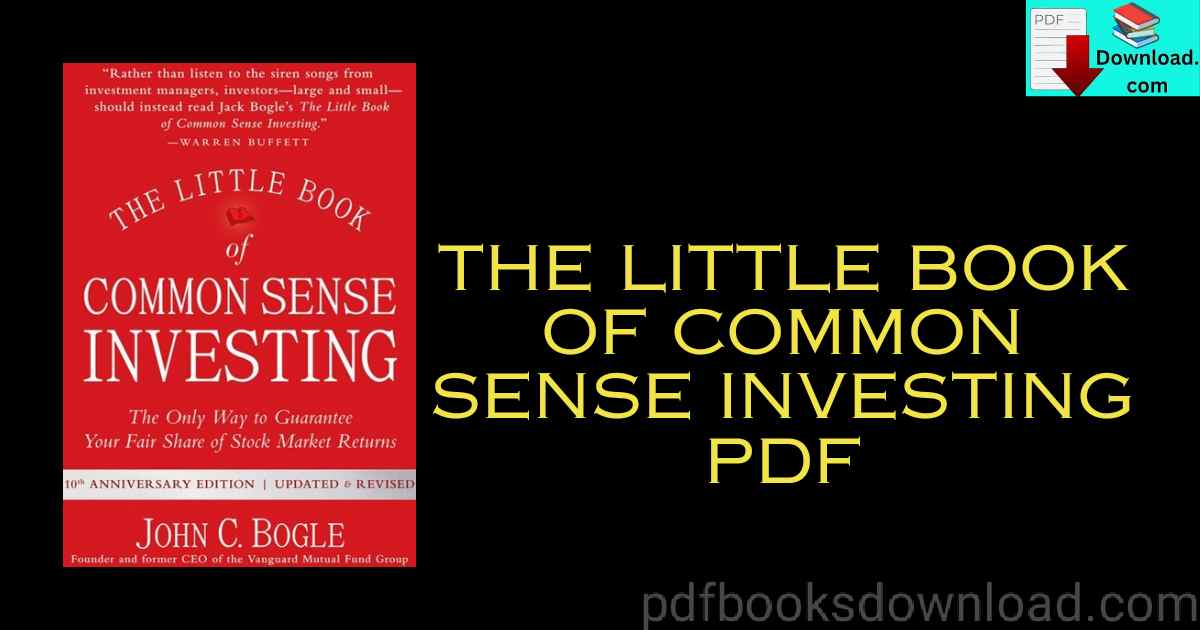| Name of Book | The Little Book Of Common Sense Investing |
| Author | John C. Bogle |
| PDF Size | 2.2 MB |
| No of Pages | 305 |
| Language | English |
Five Reasons To Read The Little Book Of Common Sense Investing PDF
Learn the Basics: “The Little Book of Common Sense Investing” breaks down investment principles into easy-to-understand language, making it accessible even if you’re new to investing. It covers fundamental concepts like diversification and long-term investing strategies.
Understand Index Funds: John C. Bogle, the author, is a pioneer of index investing. He explains why index funds are a smart choice for many investors, offering low fees and broad market exposure. Understanding index funds can help you make informed decisions about where to put your money.
Avoid Costly Mistakes: By reading this book, you can learn from the mistakes of others. Bogle highlights common investing pitfalls and how to steer clear of them. This knowledge can potentially save you money and help you build wealth more effectively over time.
Focus on the Long Term: The book emphasizes the importance of patience and discipline in investing. It teaches you to ignore short-term market fluctuations and stay focused on your long-term goals. This mindset shift can lead to more consistent and reliable returns over time.
Empower Yourself: Ultimately, “The Little Book of Common Sense Investing” empowers readers to take control of their financial future. By understanding the principles outlined in the book, you can become a more confident and knowledgeable investor, capable of making informed decisions that align with your goals.

The Little Book Of Common Sense Investing Summary
Introduction
“The Little Book of Common Sense Investing” by John C. Bogle is a timeless classic that offers valuable insights into the world of investing. Written in a simple and easy-to-understand manner, this book is a must-read for anyone looking to build wealth through smart investment strategies. In this article, we will explore the key concepts and lessons from the book.
Understanding the Basics of Investing
Investing might appear daunting, but it isn’t. Bogle breaks down the fundamentals of investing into easy-to-understand concepts. He emphasizes the importance of long-term thinking and staying disciplined, rather than trying to time the market or chase after hot stocks.
The Power of Index Funds
One of the core principles of Bogle’s investing philosophy is the use of index funds. Unlike actively managed funds, which try to beat the market, index funds simply aim to match the performance of a specific market index, such as the S&P 500. Bogle explains why index funds are a smart choice for the majority of investors, offering low costs, diversification, and consistent returns over time.
The Cost Matters Hypothesis
Bogle emphasizes the importance of minimizing investment costs. He argues that high fees erode returns over time, making it crucial to opt for low-cost investment vehicles such as index funds. Every dollar saved in fees is a dollar that compounds over time, significantly impacting long-term wealth accumulation.
Stay the Course
In the face of market fluctuations and economic uncertainties, Bogle advocates for staying the course. Timing the market is futile, and investors should focus on their long-term goals rather than short-term fluctuations. By maintaining a disciplined approach and avoiding emotional reactions, investors can ride out market volatility with confidence.
Diversification is Key
Diversification is the investor’s best friend. By spreading investments across various asset classes, industries, and geographical regions, investors can reduce risk and enhance long-term returns. Bogle emphasizes the importance of a well-diversified portfolio to withstand market downturns and capitalize on growth opportunities.
Simplicity Reigns Supreme
Complexity is the enemy of successful investing. Bogle advocates for simplicity in investment strategies, emphasizing the power of straightforward, easy-to-understand approaches. By keeping investment strategies simple and transparent, investors can avoid unnecessary risks and focus on what truly matters: long-term wealth accumulation.
Don’t Try to Beat the Market
Beating the market is a lofty goal that few achieve consistently. Instead of chasing hot stocks or timing the market, Bogle recommends focusing on capturing the market’s returns through low-cost index funds. By accepting market returns and minimizing costs, investors can achieve superior results over the long term.
Give Attention To Taxes
Bogle highlights how taxes can eat into your investment gains, stressing the need to keep them low. He suggests smart moves like holding onto investments for the long haul and making the most of tax-friendly accounts like IRAs and 401(k)s. By doing this, you can boost your returns over time and keep more of your hard-earned money working for you.
The Virtue of Patience
Patience is a virtue in investing. Bogle reminds investors that wealth accumulation is a marathon, not a sprint. By adopting a patient mindset and staying committed to their investment strategy, investors can reap the rewards of compounding over time and achieve their financial goals.
Conclusion
“The Little Book Of Common Sense Investing” offers timeless wisdom for investors of all backgrounds. By embracing simplicity, diversification, and discipline, investors can navigate the complexities of the market with confidence and achieve long-term financial success. As Bogle famously said, “In investing, you get what you don’t pay for.” So, let’s keep it simple, stay the course, and let the power of common sense guide our investment journey. For more information click

About The Author Of The Little Book Of Common Sense Investing
John C. Bogle was a visionary investor and the founder of The Vanguard Group, one of the world’s largest investment management companies. Born on May 8, 1929, in Montclair, New Jersey, Bogle showed an early interest in finance and economics.
After graduating from Princeton University in 1951, Bogle began his career at Wellington Management Company. It was there that he developed the idea of creating a mutual fund that would track the performance of the overall stock market. This revolutionary concept led to the creation of the first index mutual fund, known as the Vanguard 500 Index Fund, in 1976.
Bogle’s approach to investing emphasized simplicity, low costs, and long-term thinking. He believed that by investing in a diversified portfolio of low-cost index funds, investors could achieve better returns over time compared to actively managed funds, which often charge higher fees.
In 1999, Bogle published “The Little Book of Common Sense Investing,” which distilled his decades of investment wisdom into a concise and accessible guide for individual investors. In the book, he advocated for the principles of index investing and cautioned against the pitfalls of trying to beat the market through active management.
Throughout his career, Bogle was a tireless advocate for investors rights and transparency in the financial industry. He believed strongly in the idea of putting investors’ interests first and was a vocal critic of excessive fees and conflicts of interest.
Bogle’s contributions to the field of investing earned him numerous accolades, including being named one of the “100 Most Influential People” by Time magazine in 2004. He passed away on January 16, 2019, but his legacy continues to inspire investors around the world to take a common-sense approach to building wealth for the long term.
The Little Book Of Common Sense Investing PDF Related Books
FAQ’s About The Little Book Of Common Sense Investing

What is the main premise of “The Little Book of Common Sense Investing”?
The book emphasizes the importance of low-cost, passive index investing as a strategy for long-term financial success.
How does passive index investing differ from active investing?
Passive index investing involves buying and holding a diversified portfolio of securities that mirror a market index, such as the S&P 500, with minimal buying and selling activity. Active investing, on the other hand, involves frequent buying and selling of securities in an attempt to outperform the market.
Why does John C. Bogle advocate for passive index investing?
Bogle argues that the vast majority of active fund managers fail to consistently beat the market after accounting for fees and expenses. Passive index investing, with its low costs and broad diversification, offers investors a higher probability of capturing market returns over the long term.
How can investors implement the strategies discussed in the book?
Investors can implement the strategies by investing in low-cost index funds or exchange-traded funds (ETFs) that track broad market indices, such as those offered by Vanguard or other reputable financial institutions. They can also automate their investments and avoid making emotional decisions based on short-term market movements.
Does “The Little Book of Common Sense Investing” provide specific investment advice or recommendations?
While the book offers general guidance on investment principles and strategies, it does not provide specific investment advice or recommendations tailored to individual circumstances. Investors are encouraged to consult with a financial advisor before making investment decisions.
What evidence does John C. Bogle provide to support his arguments?
Bogle presents empirical evidence, historical data, and industry research to support his arguments for passive index investing. He highlights studies that demonstrate the difficulty of consistently outperforming the market through active management and the impact of fees on investment returns.
Is “The Little Book of Common Sense Investing” suitable for beginners?
Yes, the book is written in a straightforward and accessible manner, making it suitable for investors of all experience levels. Beginners can gain valuable insights into sound investment principles and strategies for building wealth over the long term.
Are there any criticisms or counterarguments to the ideas presented in the book?
While passive index investing has gained widespread acceptance, some critics argue that active management can still add value in certain market conditions or for specific investment objectives. Additionally, there may be debates over the optimal allocation between asset classes within a passive investment portfolio.
Thank You! Dear Reader 💖
